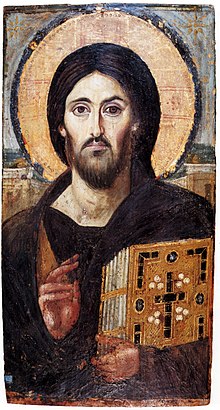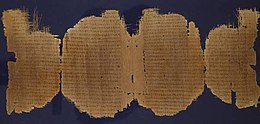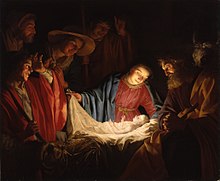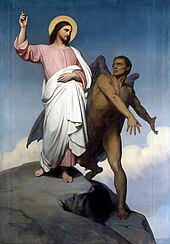jesus
jesus
Several terms redirect here. For other uses, see Jesus (disambiguation), Christ (disambiguation), Jesus Christ (disambiguation), and Jesus of Nazareth (disambiguation).
Jesus The Christ Pantocrator of Saint Catherine's Monastery at Mount Sinai, 6th century AD
The Christ Pantocrator of Saint Catherine's Monastery at Mount Sinai, 6th century AD
Bornc. 6–4 BC
Herodian kingdom, Roman Empire[1]DiedAD 30 or 33 (aged 33 or 38)
Jerusalem, Judaea,
Roman EmpireCause of deathCrucifixion[a]Known forCentral figure of Christianity
Major prophet in Islam and Druze Faith
Jesus[c] (c. 6 to 4 BC – AD 30 or 33), also referred to as Jesus Christ,[d] Jesus of Nazareth, and many other names and titles, was a first-century Jewish preacher and religious leader.[6] He is the central figure of Christianity, the world's largest religion. Most Christians believe Jesus to be the incarnation of God the Son and the awaited messiah, the Christ that is prophesied in the Old Testament.
Virtually all modern scholars of antiquity agree that Jesus existed historically.[e] Accounts of Jesus' life are contained in the Gospels, especially the four canonical Gospels in the New Testament. Academic research has yielded various views on the historical reliability of the Gospels and how closely they reflect the historical Jesus.[14][f][17][18] Jesus was circumcised at eight days old, was baptized by John the Baptist as a young adult, and after 40 days and nights of fasting in the wilderness, began his own ministry. Being an itinerant teacher, he was often referred to as "rabbi".[19] Jesus often debated with fellow Jews on how to best follow God, engaged in healings, taught in parables, and gathered followers, among whom twelve were his primary disciples. He was arrested in Jerusalem and tried by the Jewish authorities,[20] turned over to the Roman government, and crucified on the order of Pontius Pilate, the Roman prefect of Judea. After his death, his followers became convinced that he rose from the dead, and following his ascension, the community they formed eventually became the early Christian Church that expanded as a worldwide movement.[21] Accounts of his teachings and life were initially conserved by oral transmission, which was the source of the written Gospels.[22]
Christian theology includes the beliefs that Jesus was conceived by the Holy Spirit, was born of a virgin named Mary, performed miracles, founded the Christian Church, died by crucifixion as a sacrifice to achieve atonement for sin, rose from the dead, and ascended into Heaven, from where he will return. Commonly, Christians believe Jesus enables people to be reconciled to God. The Nicene Creed asserts that Jesus will judge the living and the dead, either before or after their bodily resurrection, an event tied to the Second Coming of Jesus in Christian eschatology. The great majority of Christians worship Jesus as the incarnation of God the Son, the second of three prosopons of the Trinity.[g] The birth of Jesus is celebrated annually, generally on 25 December,[h] as Christmas. His crucifixion is honoured on Good Friday and his resurrection on Easter Sunday. The world's most widely used calendar era—in which the current year is AD 2024 (or 2024 CE)—is based on the approximate birthdate of Jesus.[23]
Jesus is also revered in Islam, the Baháʼí Faith, and the Druze Faith. In Islam, Jesus (often referred to by his Quranic name ʿĪsā) is considered the penultimate prophet of God and the messiah, who will return before the Day of Judgement. Muslims believe Jesus was born of the virgin Mary but was neither God nor a son of God. Most Muslims do not believe that he was killed or crucified but that God raised him into Heaven while he was still alive.[i] In contrast, Judaism rejects the belief that Jesus was the awaited messiah, arguing that he did not fulfill messianic prophecies, was not lawfully anointed and was neither divine nor resurrected.
Name
Further information: Jesus (name), Holy Name of Jesus, Names and titles of Jesus in the New Testament, and Names of God in Christianity
Part of a series on show
show
Jesus in Christianity
show
Jesus in Islam
show
Background
show
Jesus in history
show
Perspectives on Jesus
show
Jesus in culture
vte Counter-clockwise from top-right: Hebrew, Aramaic, Greek, Latin, and English transcriptions of the name Jesus
Counter-clockwise from top-right: Hebrew, Aramaic, Greek, Latin, and English transcriptions of the name Jesus
Naming conventions
A typical Jew in Jesus' time had only one name, sometimes followed by the phrase "son of [father's name]", or the individual's hometown.[24] Thus, in the New Testament, Jesus is commonly referred to as "Jesus of Nazareth".[j] Jesus' neighbours in Nazareth referred to him as "the carpenter, the son of Mary and brother of James and Joses and Judas and Simon", "the carpenter's son", or "Joseph's son"; in the Gospel of John, the disciple Philip refers to him as "Jesus son of Joseph from Nazareth".
Etymology
The English name Jesus, from Greek Iēsous, is a rendering of Joshua (Hebrew Yehoshua, later Yeshua), and was not uncommon in Judea at the time of the birth of Jesus. Popular etymology linked the names Yehoshua and Yeshua to the verb meaning "save" and the noun "salvation".[25] The Gospel of Matthew tells of an angel that appeared to Joseph instructing him "to name him Jesus, for he will save his people from their sins".[26]
Jesus Christ
Since the early period of Christianity, Christians have commonly referred to Jesus as "Jesus Christ".[27] The word Christ was a title or office ("the Christ"), not a given name.[28][29] It derives from the Greek Χριστός (Christos),[30][31] a translation of the Hebrew mashiakh (משיח) meaning "anointed", and is usually transliterated into English as "messiah".[32] In biblical Judaism, sacred oil was used to anoint certain exceptionally holy people and objects as part of their religious investiture.[33]
Christians of the time designated Jesus as "the Christ" because they believed him to be the messiah, whose arrival is prophesied in the Hebrew Bible and Old Testament. In postbiblical usage, Christ became viewed as a name—one part of "Jesus Christ". Etymons of the term Christian (meaning a follower of Christ) have been in use since the 1st century.[34]
Life and teachings in the New Testament
Main article: Life of Jesus
Further information: New Testament places associated with Jesus
Events in theLife of Jesus
according to the canonical gospels show
show
show
show
show
show
In rest of the NT
Portals:  Christianity
Christianity  Biblevte
Biblevte
Canonical gospels
Main articles: Gospel, Gospel harmony, and Historical reliability of the Gospels A 3rd-century Greek papyrus of the Gospel of Luke
A 3rd-century Greek papyrus of the Gospel of Luke
The four canonical gospels (Matthew, Mark, Luke, and John) are the foremost sources for the life and message of Jesus.[24] But other parts of the New Testament also include references to key episodes in his life, such as the Last Supper in 1 Corinthians 11:23–26.[35][36][37][38] Acts of the Apostles[39] refers to Jesus' early ministry and its anticipation by John the Baptist.[40][41][6] Acts 1:1–11[42] says more about the Ascension of Jesus[43] than the canonical gospels do.[44] In the undisputed Pauline letters, which were written earlier than the Gospels, Jesus' words or instructions are cited several times.[45][k]
Some early Christian groups had separate descriptions of Jesus' life and teachings that are not in the New Testament. These include the Gospel of Thomas, Gospel of Peter, and Gospel of Judas, the Apocryphon of James, and many other apocryphal writings. Most scholars conclude that these were written much later and are less reliable accounts than the canonical gospels.[48][49][50]
Authorship, date, and reliability
The canonical gospels are four accounts, each by a different author. The authors of the Gospels are pseudonymous, attributed by tradition to the four evangelists, each with close ties to Jesus:[51] Mark by John Mark, an associate of Peter;[52] Matthew by one of Jesus' disciples;[51] Luke by a companion of Paul mentioned in a few epistles;[51] and John by another of Jesus' disciples,[51] the "beloved disciple".[53]
According to the Marcan priority, the first to be written was the Gospel of Mark (written AD 60–75), followed by the Gospel of Matthew (AD 65–85), the Gospel of Luke (AD 65–95), and the Gospel of John (AD 75–100).[54] Most scholars agree that the authors of Matthew and Luke used Mark as a source for their gospels. Since Matthew and Luke also share some content not found in Mark, many scholars assume that they used another source (commonly called the "Q source") in addition to Mark.[55]
One important aspect of the study of the Gospels is the literary genre under which they fall. Genre "is a key convention guiding both the composition and the interpretation of writings".[56] Whether the gospel authors set out to write novels, myths, histories, or biographies has a tremendous impact on how they ought to be interpreted. Some recent studies suggest that the genre of the Gospels ought to be situated within the realm of ancient biography.[57][58][59] Although not without critics,[60] the position that the Gospels are a type of ancient biography is the consensus among scholars today.[61][62]
Concerning the accuracy of the accounts, viewpoints run the gamut from considering them inerrant descriptions of Jesus' life,[63] to doubting whether they are historically reliable on a number of points,[64] to considering them to provide very little historical information about his life beyond the basics.[65][66] According to a broad scholarly consensus, the Synoptic Gospels (the first three—Matthew, Mark, and Luke) are the most reliable sources of information about Jesus.[67][68][24]
Comparative structure and content
Part of a series onChristianity show
show
show
- BibleFoundations
show
show
show
show
Related topics
vte
Matthew, Mark, and Luke are known as the Synoptic Gospels, from the Greek σύν (syn "together") and ὄψις (opsis "view"),[69][70][71] because they are similar in content, narrative arrangement, language and paragraph structure, and one can easily set them next to each other and synoptically compare what is in them.[69][70][72] Scholars generally agree that it is impossible to find any direct literary relationship between the Synoptic Gospels and the Gospel of John.[73] While the flow of many events (e.g., Jesus' baptism, transfiguration, crucifixion and interactions with his apostles) are shared among the Synoptic Gospels, incidents such as the transfiguration and Jesus' exorcising demons[74] do not appear in John, which also differs on other matters, such as the Cleansing of the Temple.[75]
The Synoptics emphasize different aspects of Jesus. In Mark, Jesus is the Son of God whose mighty works demonstrate the presence of God's Kingdom.[52] He is a tireless wonder worker, the servant of both God and man.[76] This short gospel records few of Jesus' words or teachings.[52] The Gospel of Matthew emphasizes that Jesus is the fulfilment of God's will as revealed in the Old Testament, and the Lord of the Church.[77] He is the "Son of David", a "king", and the messiah.[76][78] Luke presents Jesus as the divine-human saviour who shows compassion to the needy.[79] He is the friend of sinners and outcasts, come to seek and save the lost.[76] This gospel includes well-known parables, such as the Good Samaritan and the Prodigal Son.[79]
The prologue to the Gospel of John identifies Jesus as an incarnation of the divine Word (Logos).[80] As the Word, Jesus was eternally present with God, active in all creation, and the source of humanity's moral and spiritual nature.[80] Jesus is not only greater than any past human prophet but greater than any prophet could be. He not only speaks God's Word; he is God's Word.[81] In the Gospel of John, Jesus reveals his divine role publicly. Here he is the Bread of Life, the Light of the World, the True Vine and more.[76]
In general, the authors of the New Testament showed little interest in an absolute chronology of Jesus or in synchronizing the episodes of his life with the secular history of the age.[82] As stated in John 21:25, the Gospels do not claim to provide an exhaustive list of the events in Jesus' life.[83] The accounts were primarily written as theological documents in the context of early Christianity, with timelines as a secondary consideration.[84] In this respect, it is noteworthy that the Gospels devote about one third of their text to the last week of Jesus' life in Jerusalem, referred to as the Passion.[85] The Gospels do not provide enough details to satisfy the demands of modern historians regarding exact dates, but it is possible to draw from them a general picture of Jesus' life story.[64][82][84]
Genealogy and nativity
Main articles: Genealogy of Jesus and Nativity of Jesus
Jesus was Jewish,[6] born to Mary, wife of Joseph.[86] The Gospels of Matthew and Luke offer two accounts of his genealogy. Matthew traces Jesus' ancestry to Abraham through David.[87][88] Luke traces Jesus' ancestry through Adam to God.[89][90] The lists are identical between Abraham and David but differ radically from that point. Matthew has 27 generations from David to Joseph, whereas Luke has 42, with almost no overlap between the names on the two lists.[l][91] Various theories have been put forward to explain why the two genealogies are so different.[m] Adoration of the Shepherds by Gerard van Honthorst, 1622
Adoration of the Shepherds by Gerard van Honthorst, 1622
Matthew and Luke each describe Jesus' birth, especially that Jesus was born to a virgin named Mary in Bethlehem in fulfilment of prophecy. Luke's account emphasizes events before the birth of Jesus and centers on Mary, while Matthew's mostly covers those after the birth and centers on Joseph.[92][93][94] Both accounts state that Jesus was born to Joseph and Mary, his betrothed, in Bethlehem, and both support the doctrine of the virgin birth of Jesus, according to which Jesus was miraculously conceived by the Holy Spirit in Mary's womb when she was still a virgin.[95][96][97] At the same time, there is evidence, at least in the Lukan Acts of the Apostles, that Jesus was thought to have had, like many figures in antiquity, a dual paternity, since there it is stated he descended from the seed or loins of David.[98] By taking him as his own, Joseph will give him the necessary Davidic descent.[99] Some scholars suggest that Jesus had Levite heritage from Mary, based on her blood relationship with Elizabeth. [100] The Circumcision by Giovanni Bellini, c. 1500. The work depicts the circumcision of Jesus.
The Circumcision by Giovanni Bellini, c. 1500. The work depicts the circumcision of Jesus.
In Matthew, Joseph is troubled because Mary, his betrothed, is pregnant,[101] but in the first of Joseph's four dreams an angel assures him not to be afraid to take Mary as his wife, because her child was conceived by the Holy Spirit.[102] In Matthew 2:1–12, wise men or Magi from the East bring gifts to the young Jesus as the King of the Jews. They find him in a house in Bethlehem. Herod the Great hears of Jesus' birth and, wanting him killed, orders the murders of male infants in Bethlehem and its surroundings. But an angel warns Joseph in his second dream, and the family flees to Egypt—later to return and settle in Nazareth.[102][103][104]
In Luke 1:31–38, Mary learns from the angel Gabriel that she will conceive and bear a child called Jesus through the action of the Holy Spirit.[93][95] When Mary is due to give birth, she and Joseph travel from Nazareth to Joseph's ancestral home in Bethlehem to register in the census ordered by Caesar Augustus. While there Mary gives birth to Jesus, and as they have found no room in the inn, she places the newborn in a manger.[105] An angel announces the birth to a group of shepherds, who go to Bethlehem to see Jesus, and subsequently spread the news abroad.[106] Luke 2:21 tells how Joseph and Mary have their baby circumcised on the eighth day after birth, and name him Jesus, as Gabriel had commanded Mary.[107] After the presentation of Jesus at the Temple, Joseph, Mary and Jesus return to Nazareth.[93][95]
Early life, family, and profession
Main article: Christ Child
See also: Return of the family of Jesus to Nazareth, Unknown years of Jesus, and Brothers of Jesus The Finding of the Saviour in the Temple, by William Holman Hunt, 1860
The Finding of the Saviour in the Temple, by William Holman Hunt, 1860
Jesus' childhood home is identified in the Gospels of Luke and Matthew as the town of Nazareth in Galilee, where he lived with his family. Although Joseph appears in descriptions of Jesus' childhood, no mention is made of him thereafter.[108][109] His other family members—his mother, Mary, his brothers James, Joses (or Joseph), Judas and Simon and his unnamed sisters—are mentioned in the Gospels and other sources.[110] Jesus' maternal grandparents are named Joachim and Anne in the Gospel of James.[111] The Gospel of Luke records that Mary was a relative of Elizabeth, the mother of John the Baptist.[112] Extra-biblical contemporary sources consider Jesus and John the Baptist to be second cousins through the belief that Elizabeth was the daughter of Sobe, the sister of Anne.[113][114][115]
The Gospel of Mark reports that at the beginning of his ministry, Jesus comes into conflict with his neighbours and family.[116] Jesus' mother and brothers come to get him[117] because people are saying that he is crazy.[118] Jesus responds that his followers are his true family. In the Gospel of John, Jesus and his mother attend a wedding at Cana, where he performs his first miracle at her request.[119] Later, she follows him to his crucifixion, and he expresses concern over her well-being.[120]
Jesus is called a τέκτων (tektōn) in Mark 6:3, a term traditionally understood as carpenter but could also refer to makers of objects in various materials, including builders.[121][122] The Gospels indicate that Jesus could read, paraphrase, and debate scripture, but this does not necessarily mean that he received formal scribal training.[123]
The Gospel of Luke reports two journeys of Jesus and his parents in Jerusalem during his childhood. They come to the Temple in Jerusalem for the presentation of Jesus as a baby in accordance with Jewish Law, where a man named Simeon prophesies about Jesus and Mary.[124] When Jesus, at the age of twelve, goes missing on a pilgrimage to Jerusalem for Passover, his parents find him in the temple sitting among the teachers, listening to them and asking questions, and the people are amazed at his understanding and answers. Mary scolds Jesus for going missing, to which Jesus replies that he must "be in his father's house".[125]
Baptism and temptation
Main articles: Baptism of Jesus and Temptation of Christ The Baptism of Christ by John the Baptist, by José Ferraz de Almeida Júnior, 1895
The Baptism of Christ by John the Baptist, by José Ferraz de Almeida Júnior, 1895
The synoptic gospels describe Jesus' baptism in the Jordan River and the temptations he received while spending forty days in the Judaean Desert, as a preparation for his public ministry.[126] The accounts of Jesus' baptism are all preceded by information about John the Baptist.[127][128][129] They show John preaching penance and repentance for the remission of sins and encouraging the giving of alms to the poor[130] as he baptizes people in the area of the Jordan River around Perea and foretells the arrival of someone "more powerful" than he.[131][132] Jesus and the devil depicted in The Temptation of Christ, by Ary Scheffer, 1854
Jesus and the devil depicted in The Temptation of Christ, by Ary Scheffer, 1854
In the Gospel of Mark, John the Baptist baptizes Jesus, and as he comes out of the water he sees the Holy Spirit descending to him like a dove and a voice comes from heaven declaring him to be God's Son.[133] This is one of two events described in the Gospels where a voice from Heaven calls Jesus "Son", the other being the Transfiguration.[134][135] The spirit then drives him into the wilderness where he is tempted by Satan.[136] Jesus then begins his ministry in Galilee after John's arrest.[137]
In the Gospel of Matthew, as Jesus comes to him to be baptized, John protests, saying, "I need to be baptized by you."[138] Jesus instructs him to carry on with the baptism "to fulfill all righteousness".[139] Matthew details three temptations that Satan offers Jesus in the wilderness.[140]
In the Gospel of Luke, the Holy Spirit descends as a dove after everyone has been baptized and Jesus is praying.[141] Later John implicitly recognizes Jesus (possibly from prison[citation needed]) after sending his followers to ask about him.[142] Luke also describes three temptations received by Jesus in the wilderness, before starting his ministry in Galilee.[143]
The Gospel of John leaves out Jesus' baptism and temptation.[144] Here, John the Baptist testifies that he saw the Spirit descend on Jesus.[145][146] John publicly proclaims Jesus as the sacrificial Lamb of God, and some of John's followers become disciples of Jesus.[68] Before John is imprisoned, Jesus leads his followers to baptize disciples as well,[147] and they baptize more people than John.[148]
Public ministry
Main article: Ministry of Jesus Sermon on the Mount, by Carl Bloch, 1877, depicts Jesus' important discourse.
Sermon on the Mount, by Carl Bloch, 1877, depicts Jesus' important discourse.
The Synoptics depict two distinct geographical settings in Jesus' ministry. The first takes place north of Judea, in Galilee, where Jesus conducts a successful ministry, and the second shows Jesus rejected and killed when he travels to Jerusalem.[19] Often referred to as "rabbi",[19] Jesus preaches his message orally.[22] Notably, Jesus forbids those who recognize him as the messiah to speak of it, including people he heals and demons he exorcises (see Messianic Secret).[149]
John depicts Jesus' ministry as largely taking place in and around Jerusalem, rather than in Galilee; and Jesus' divine identity is openly proclaimed and immediately recognized.[81]
Scholars divide the ministry of Jesus into several stages. The Galilean ministry begins when Jesus returns to Galilee from the Judaean Desert after rebuffing the temptation of Satan. Jesus preaches around Galilee, and in Matthew 4:18–20, his first disciples, who will eventually form the core of the early Church, encounter him and begin to travel with him.[129][150] This period includes the Sermon on the Mount, one of Jesus' major discourses,[150][151] as well as the calming of the storm, the feeding of the 5,000, walking on water and a number of other miracles and parables.[152] It ends with the Confession of Peter and the Transfiguration.[153][154]
As Jesus travels towards Jerusalem, in the Perean ministry, he returns to the area where he was baptized, about a third of the way down from the Sea of Galilee along the Jordan River.[155][156][157] The final ministry in Jerusalem begins with Jesus' triumphal entry into the city on Palm Sunday.[158] In the Synoptic Gospels, during that week Jesus drives the money changers from the Second Temple and Judas bargains to betray him. This period culminates in the Last Supper and the Farewell Discourse.[127][158][159]
Disciples and followers
Main articles: Apostles in the New Testament and Commissioning of the Twelve Apostles The Exhortation to the Apostles, by James Tissot, portrays Jesus talking to his 12 disciples.
The Exhortation to the Apostles, by James Tissot, portrays Jesus talking to his 12 disciples.
Near the beginning of his ministry, Jesus appoints twelve apostles. In Matthew and Mark, despite Jesus only briefly requesting that they join him, Jesus' first four apostles, who were fishermen, are described as immediately consenting, and abandoning their nets and boats to do so.[160] In John, Jesus' first two apostles were disciples of John the Baptist. The Baptist sees Jesus and calls him the Lamb of God; the two hear this and follow Jesus.[161][162] In addition to the Twelve Apostles, the opening of the passage of the Sermon on the Plain identifies a much larger group of people as disciples.[163] Also, in Luke 10:1–16 Jesus sends 70 or 72 of his followers in pairs to prepare towns for his prospective visit. They are instructed to accept hospitality, heal the sick, and spread the word that the Kingdom of God is coming.[164]
In Mark, the disciples are notably obtuse. They fail to understand Jesus' miracles,[165] his parables,[166] or what "rising from the dead" means.[167] When Jesus is later arrested, they desert him.[149]













































